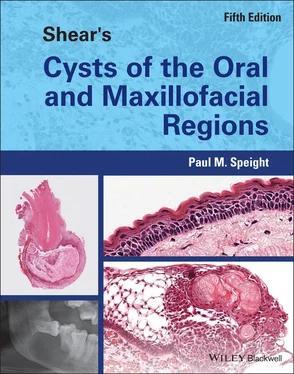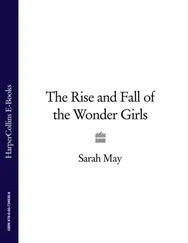Paul M. Speight - Shear's Cysts of the Oral and Maxillofacial Regions
Здесь есть возможность читать онлайн «Paul M. Speight - Shear's Cysts of the Oral and Maxillofacial Regions» — ознакомительный отрывок электронной книги совершенно бесплатно, а после прочтения отрывка купить полную версию. В некоторых случаях можно слушать аудио, скачать через торрент в формате fb2 и присутствует краткое содержание. Жанр: unrecognised, на английском языке. Описание произведения, (предисловие) а так же отзывы посетителей доступны на портале библиотеки ЛибКат.
- Название:Shear's Cysts of the Oral and Maxillofacial Regions
- Автор:
- Жанр:
- Год:неизвестен
- ISBN:нет данных
- Рейтинг книги:5 / 5. Голосов: 1
-
Избранное:Добавить в избранное
- Отзывы:
-
Ваша оценка:
- 100
- 1
- 2
- 3
- 4
- 5
Shear's Cysts of the Oral and Maxillofacial Regions: краткое содержание, описание и аннотация
Предлагаем к чтению аннотацию, описание, краткое содержание или предисловие (зависит от того, что написал сам автор книги «Shear's Cysts of the Oral and Maxillofacial Regions»). Если вы не нашли необходимую информацию о книге — напишите в комментариях, мы постараемся отыскать её.
Shear’s Cysts of the Oral and Maxillofacial Regions
Shear’s Cysts of the Oral and Maxillofacial Regions Fifth Edition
Shear's Cysts of the Oral and Maxillofacial Regions — читать онлайн ознакомительный отрывок
Ниже представлен текст книги, разбитый по страницам. Система сохранения места последней прочитанной страницы, позволяет с удобством читать онлайн бесплатно книгу «Shear's Cysts of the Oral and Maxillofacial Regions», без необходимости каждый раз заново искать на чём Вы остановились. Поставьте закладку, и сможете в любой момент перейти на страницу, на которой закончили чтение.
Интервал:
Закладка:
It is interesting that these figures contrast starkly with data from other studies that have shown that paradental cysts are exceedingly rare or are not diagnosed at all. Six of the studies shown in Table 4.1did not record any inflammatory collateral cysts. Costa et al. (2014 ) also reviewed 11 studies that reported histological findings associated with third molars in 8464 patients. The most common finding was of normal dental follicle (76%), but the most common lesions were dentigerous cysts, found in 410 cases (11%). Only one paper (Al‐Khateeb and Bataineb 2006 ) reported finding any paradental cysts and there were only 2, suggesting an overall prevalence of 0.05%. In a systematic review of the prevalence of odontogenic cysts and tumours associated with impacted third molars, Mello et al. (2019 ) reviewed 16 studies reporting histological diagnoses associated with more than 50 000 teeth. There were 1371 cysts, of which 783 (57.1%) were dentigerous cysts, 400 (29.2%) radicular cysts, and 150 (10.9%) odontogenic keratocysts. These authors also found the same single study (Al‐Khateeb and Bataineb 2006 ) that had reported only 2 paradental cysts. These data are similar to other studies that have examined tissues associated with impacted third molars and have not reported a single paradental cyst (e.g. Curran et al. 2002 [USA]; Stathopoulos et al. 2011 [Greece]; Patil et al. 2014 [India]).
Table 4.2 Paradental cysts. Age, sex, and site distribution from selected reports, and from the review of 222 cases by Philipsen et al. (2004 ).
| References | n | Mean age a | Age range | Male (%) | % Bilateral |
|---|---|---|---|---|---|
| Craig (1976 ) | 48 | 3rd decade | NR | 83.0 | 2.1 |
| Ackermann et al. (1987 ) | 50 | 3rd decade | 17–62 | 70.0 | 6.0 |
| Vedtofte and Praetorius (1989 ) | 15 | 24.4 | 18–34 | 60.0 | 0.0 |
| de Sousa et al. (2001 ) | 54 b | 3rd decade | 13–47 | 39.0 | NR |
| Colgan et al. (2002 ) | 15 | 27.4 | 18–43 | 46.6 | 6.6 |
| Jones et al. (2006 ) | 376 | 29.6 | 17–74 | 57.3 | NR |
| Philipsen et al. (2004 ) | 11 | 29.9 | 18–46 | 63.6 | 18.0 |
| Tamiolakis et al. (2019 ) | 53 | 29.3 | 18–56 | 52.8 | NR |
| Mohammed et al. (2019 ) | 23 | 30.2 | 11–51 | 69.5 | NR |
| Philipsen et al. (2004 ) | 222 c | 27.6 | 18–47 | 70.6 | 4.1 |
n, number of patients; NR, not reported.
aIn some reports, the mean age is not given, so the peak decade is included.
bIncludes three cases on first or second molars.
cTotal cases reviewed, n for each parameter varies.
Table 4.3 Mandibular buccal bifurcation cysts. Age, sex, and site distribution from selected reports, and from the review of 110 cases by Philipsen et al. (2004 ) (see text for discussion).
| References | First molars | Second molars | |||||||
|---|---|---|---|---|---|---|---|---|---|
| n | % Male | % Bilateral | n | Mean age | Age range | n | Mean age | Age range | |
| Vedtofte and Praetorius (1989 ) | 12 | 33.3 | 16.6 | 5 | 8.0 | 7–9 | 7 | 13.3 | 11–15 |
| Wolf and Hietanen (1990 ) | 6 | 16.6 | NR | 3 | 7.3 | 6–9 | 3 | 13.0 | 12–14 |
| Thurnwald et al. (1994 ) | 10 | 70.0 | 40.0 | 10 | 7.7 | 5–9 | – | – | – |
| Pompura et al. (1997 ) | 32 | 43.7 | 37.5 | 32 | 7.5 | 5–11 | – | – | – |
| Philipsen et al. (2004 ) | 110 a | 55.2 | 23.9 | 36 | 8.7 | 5–47 | 13 | 17.4 | 10–40 |
n = number of patients; NR, not reported.
aTotal cases reviewed, n for each parameter varies.
These data cannot be taken to represent the true prevalence of paradental cysts because many studies were based in surgical units, the criteria for diagnosis are not given, and although most report ‘impacted’ teeth, it is rarely stated whether the tooth is fully unerupted or partially erupted. These studies do, however, suggest that many clinicians may not recognise or diagnose paradental cysts.
There is some evidence that many clinicians and pathologists in the United States may not recognise the paradental cyst as an entity, but rather regard it as a variant of dentigerous cyst. One of the best and most widely used textbooks on oral and maxillofacial pathology (Neville et al. 2016 ) recognises the buccal bifurcation cyst in children, but is uncertain about the paradental cyst. Its authors agree that the features may be due to chronic pericoronitis, but suggest that most are probably diagnosed as examples of inflamed dentigerous cysts. Two other excellent and widely used textbooks take a similar stance and suggest that the paradental cyst is an inflamed dentigerous cyst that has become buccally or distally displaced, presumably as a result of eruption of the tooth (Woo 2016 ; Regezi et al. 2017 ).
In a study from the United States of 2646 pericoronal lesions associated with impacted teeth, Curran et al. (2002 ) did not identify a single case of paradental cyst. They reported that 67% (1776 lesions) were diagnosed as normal follicular tissue and of the remaining pathologically significant lesions (n = 872), 86.6% (n = 752) were diagnosed as dentigerous cysts. This suggests that in this centre, paradental cysts were not recognised as an entity and were probably diagnosed as dentigerous cysts. The paper was challenged on this issue by Slater (2003 ), who suggested in correspondence that some of the dentigerous cysts diagnosed by Curran et al. (2002 ) may in fact be paradental cysts. It is not stated, however, how many of their impacted teeth were unerupted or partially erupted.
These discrepancies in frequency or prevalence are almost certainly due to uncertainty about the criteria for diagnosis and the fact that pericoronal radiolucencies associated with partially erupted third molars are often given a clinical or radiological diagnosis of ‘dentigerous cyst’, ‘pericoronitis’, or ‘hyperplastic follicle’. The pathologist may receive only fragments of inflamed tissue that may be consistent with any of these diagnoses, and paradental cyst may not be considered. The differential diagnosis of the paradental cyst and criteria for diagnosis will be discussed later in this chapter.
Age
The mean age of presentation of inflammatory collateral cysts correlates well with the chronological stage of eruption, with lesions most often presenting a few years after the eruption of the associated tooth. The mandibular buccal bifurcation cyst presents in children, but the mean age of presentation depends on the tooth affected ( Table 4.3). Lesions on first molars are found at a mean age of about 8 years, with most studies showing a narrow range between 5 and 11 years. Cysts on second molars are found at a mean age of about 13 years. In their review of more than 40 papers, Philipsen et al. (2004 ) found limited demographic data, but showed a wider age range than suggested in the literature. The age range for lesions on first molars and second molars was reported as 5–47 years and 10–40 years, respectively. However, careful reading of their paper shows that there was only one first molar cyst in a patient over 11 years (a male age 47) and this was from their own files. They also found only three cases over the age of 16 on second molars, and two of these were from their own files.
Читать дальшеИнтервал:
Закладка:
Похожие книги на «Shear's Cysts of the Oral and Maxillofacial Regions»
Представляем Вашему вниманию похожие книги на «Shear's Cysts of the Oral and Maxillofacial Regions» списком для выбора. Мы отобрали схожую по названию и смыслу литературу в надежде предоставить читателям больше вариантов отыскать новые, интересные, ещё непрочитанные произведения.
Обсуждение, отзывы о книге «Shear's Cysts of the Oral and Maxillofacial Regions» и просто собственные мнения читателей. Оставьте ваши комментарии, напишите, что Вы думаете о произведении, его смысле или главных героях. Укажите что конкретно понравилось, а что нет, и почему Вы так считаете.












